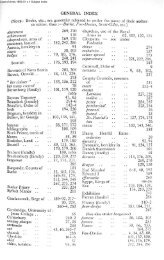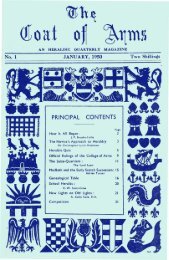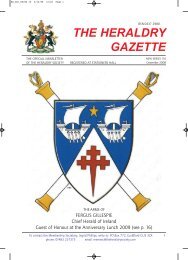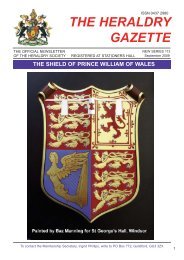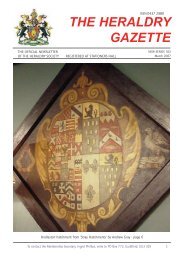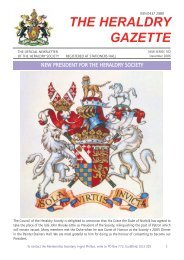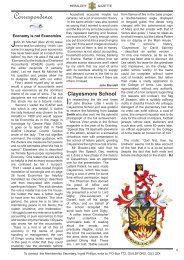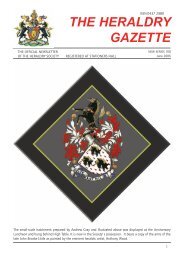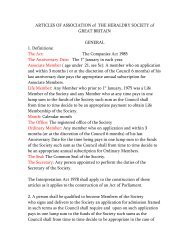You also want an ePaper? Increase the reach of your titles
YUMPU automatically turns print PDFs into web optimized ePapers that Google loves.
ooch of French Imperial design that she had<br />
purchased in Paris. I took this eagle brooch to<br />
the Admiralty to show Mr Churchill and Admiral<br />
Prince Louis of Battenberg. <strong>The</strong>y much<br />
preferred it to the goose design of the artist and<br />
adopted it for the badge of the Royal Naval Air<br />
Service.”<br />
<strong>The</strong> Royal Naval Air Service came into being<br />
on 1 July 1914, and the initial dress regulations<br />
were promulgated in Admiralty Weekly Order<br />
No 2, where there is a first official reference to<br />
the emblem of the navy’s new air arm: “<strong>The</strong><br />
badge of an eagle will be worn by members of<br />
the Royal Naval Air Service at the top left<br />
sleeve”. Later, when it was felt that aircrew<br />
should be further differentiated, Admiralty<br />
Weekly Order 756/16, of 21 April 1916, stated<br />
that in addition to the eagle on the left sleeve a<br />
further eagle should be worn on the left<br />
shoulder strap. <strong>The</strong>n, on 8 June 1917, in<br />
Admiralty Weekly Order 2106/17, aircrew were<br />
required to wear the eagle on both sleeves and<br />
both shoulder straps.<br />
With so many references to the eagle, there<br />
can be no doubt as to its use by the Royal<br />
Naval Air Service, or to its subsequent use by<br />
the newly-formed Royal Air Force, which<br />
adopted the rank badges of the Royal Naval Air<br />
Service and the rank titles of the Royal Flying<br />
Corps. As such, a lieutenant colonel wore<br />
“three rows of distinguishing lace surmounted<br />
by bird (sic) and crown”, the latter being similar<br />
to the badge on an officer’s field service cap of<br />
today. It was not until 27 August 1919 that an<br />
Air Council Order replaced army titles of rank<br />
with Royal Air Force titles of rank, and<br />
consigned the ‘bird and crown’ device from the<br />
sleeve to the shoulder strap.<br />
Having used Admiralty Orders to establish<br />
that the Royal Naval Air Service emblem was<br />
an eagle, and Air Ministry Orders to confirm<br />
that the eagle had been adopted by the Royal<br />
Air Force, it would seem that these same<br />
orders could be used to reveal the genesis of<br />
the albatross debate. From 1 April 1918, the<br />
Royal Air Force undertook all Service flying<br />
training, and detached some of its air and<br />
ground crews for service with the Royal Navy.<br />
In April 1924 these detachments were<br />
designated the Fleet Air Arm of the Royal Air<br />
Force. Soon afterwards, naval officers began<br />
to train as pilots with the Royal Air Force, and<br />
they then joined its fleet air arm: but the<br />
Admiralty decided to award its own flying<br />
badge. So, when Admiralty Fleet Order No<br />
2793 was issued, on 2 October 1925, it<br />
described the new badge for navy pilots as: “A<br />
silver anchor and cable of silver embroidery<br />
surrounded by a laurel wreath of silver<br />
embroidery superimposed on the wings of an<br />
albatross”.<br />
So, with the albatross attributed to the Royal<br />
Navy of 1925, and the eagle established as the<br />
emblem of the Royal Air Force from 1918,<br />
attention now turns to the motto which is<br />
inscribed on the circlet.<br />
Having been approved by George V, ‘Per<br />
Ardua Ad Astra’ was promulgated as the motto<br />
for the Royal Flying Corps in Army Order No 3,<br />
on 15 March 1913. <strong>The</strong> motto had been<br />
suggested by Lieutenant J S Yule, of the Royal<br />
Engineers, who discovered the words in Sir<br />
Henry Rider Haggard’s novel ‘<strong>The</strong> People of<br />
the Mist’. In the first chapter there is a<br />
description of “two stone pillars on whose<br />
summit stood griffins of black marble<br />
embracing coats of arms and banners<br />
inscribed with the device Per Ardua Ad Astra”.<br />
According to Group Captain A H Stradling in<br />
his ‘Customs of the Services’, published by<br />
Gale and Polden in 1966, Rider Haggard’s<br />
source was the Irish family of Mulvany, whose<br />
motto it had been for centuries. But its<br />
meaning was in dispute. According to<br />
Squadron Leader P G Herring, in his ‘Customs<br />
and Traditions of the Royal Air Force’,<br />
published by Gale and Polden in 1961, the<br />
Mulvany family understood the meaning of the<br />
motto to be “Through Difficulties to the Skies”,<br />
whilst Rider Haggard believed it to be “Through<br />
Struggle to the Stars”. Seeking literal meaning<br />
of the motto, the Air Ministry approached the<br />
College of Arms, who declared that no<br />
authoritative translation was possible. So in<br />
the words of a contemporary postscript by the<br />
Air Council Member for Personnel, “Let<br />
everyone translate it as they think fit”.<br />
Group Captain P J Rodgers MBE FRAeS<br />
RAF (Retd)<br />
Items for inclusion in the Gazette: post to the Editor, <strong>The</strong> <strong>Heraldry</strong> Gazette, at the address<br />
given on page 10 or by e-mail to gazette@theheraldrysociety.com<br />
3



